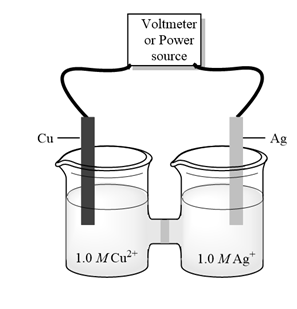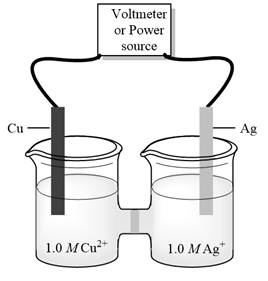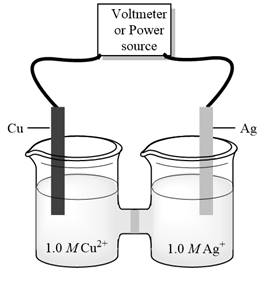
Concept explainers
a)
Interpretation:Silver metal is product of cell given below then whether given cell is galvanic or electrolytic cell should be determined. Also, cathode, anode, and direction of flow of electrons should be determined.

Concept introduction:
b)
Interpretation:Copper metal is product of cell given below then whether given cell is galvanic or electrolytic cell should be determined. Also, cathode, anode, and direction of flow of electrons should be determined.

Concept introduction:Electrolysis is method to transform electrical energy into chemical energy. Electrolytic cells transform electric energy into a chemical energy. In these cells, non-spontaneous reactions occur so energy is supplied for their occurrence. These cells have positive charged anode and negative cathode.
c)
Interpretation:Standard potential of galvanic cell below should be determined.

Concept introduction:Electrolysis is method to transform electrical energy into chemical energy. Electrolytic cells transform electric energy into a chemical energy. In these cells, non-spontaneous reactions occur so energy is supplied for their occurrence. These cells have positive charged anode and negative cathode.
d)
Interpretation:Minimum external potential needed to cause reaction to occursin electrolytic cell given below should be determined.

Concept introduction:Electrolysis is method to transform electrical energy into chemical energy. Electrolytic cells transform electric energy into a chemical energy. In these cells, non-spontaneous reactions occur so energy is supplied for their occurrence. These cells have positive charged anode and negative cathode.
Want to see the full answer?
Check out a sample textbook solution
Chapter 11 Solutions
EBK WEBASSIGN FOR ZUMDAHL'S CHEMICAL PR
- Provide the drawing of the unknown structure that corresponds with this data.arrow_forward20.44 The Diels-Alder reaction is not limited to making six-membered rings with only car- bon atoms. Predict the products of the following reactions that produce rings with atoms other than carbon in them. OCCH OCCH H (b) CH C(CH₂)s COOCH མ་ནས་བ (c) N=C H -0.X- (e) H C=N COOCHS + CH2=CHCH₂ →→arrow_forwardGiven the attached data, provide the drawing for the corresponding structure.arrow_forward
 Introductory Chemistry: A FoundationChemistryISBN:9781337399425Author:Steven S. Zumdahl, Donald J. DeCostePublisher:Cengage Learning
Introductory Chemistry: A FoundationChemistryISBN:9781337399425Author:Steven S. Zumdahl, Donald J. DeCostePublisher:Cengage Learning General Chemistry - Standalone book (MindTap Cour...ChemistryISBN:9781305580343Author:Steven D. Gammon, Ebbing, Darrell Ebbing, Steven D., Darrell; Gammon, Darrell Ebbing; Steven D. Gammon, Darrell D.; Gammon, Ebbing; Steven D. Gammon; DarrellPublisher:Cengage Learning
General Chemistry - Standalone book (MindTap Cour...ChemistryISBN:9781305580343Author:Steven D. Gammon, Ebbing, Darrell Ebbing, Steven D., Darrell; Gammon, Darrell Ebbing; Steven D. Gammon, Darrell D.; Gammon, Ebbing; Steven D. Gammon; DarrellPublisher:Cengage Learning Chemistry: An Atoms First ApproachChemistryISBN:9781305079243Author:Steven S. Zumdahl, Susan A. ZumdahlPublisher:Cengage Learning
Chemistry: An Atoms First ApproachChemistryISBN:9781305079243Author:Steven S. Zumdahl, Susan A. ZumdahlPublisher:Cengage Learning Chemistry by OpenStax (2015-05-04)ChemistryISBN:9781938168390Author:Klaus Theopold, Richard H Langley, Paul Flowers, William R. Robinson, Mark BlaserPublisher:OpenStax
Chemistry by OpenStax (2015-05-04)ChemistryISBN:9781938168390Author:Klaus Theopold, Richard H Langley, Paul Flowers, William R. Robinson, Mark BlaserPublisher:OpenStax World of Chemistry, 3rd editionChemistryISBN:9781133109655Author:Steven S. Zumdahl, Susan L. Zumdahl, Donald J. DeCostePublisher:Brooks / Cole / Cengage Learning
World of Chemistry, 3rd editionChemistryISBN:9781133109655Author:Steven S. Zumdahl, Susan L. Zumdahl, Donald J. DeCostePublisher:Brooks / Cole / Cengage Learning Chemistry for Engineering StudentsChemistryISBN:9781337398909Author:Lawrence S. Brown, Tom HolmePublisher:Cengage Learning
Chemistry for Engineering StudentsChemistryISBN:9781337398909Author:Lawrence S. Brown, Tom HolmePublisher:Cengage Learning





